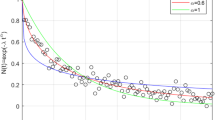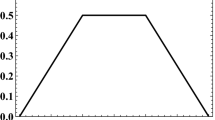Abstract
Let \(C_1\) and \(C_2\) be two Cantor sets in \({\mathbb {R}}\). Suppose that the size of the largest gap of \(C_1\) is not greater than the diameter of \(C_2\), and vice versa. Newhouse (Hyperbolicity and sensitive chaotic dynamics at homoclinic bifurcations, volume 35 of Cambridge Studies in Advanced Mathematics. Fractal dimensions and infinitely many attractors. Cambridge University Press, Cambridge, 1993) proved if \(\tau (C_1)\cdot \tau (C_2)\ge 1\), then the arithmetic sum \(C_1+C_2\) is an interval, where \(\tau (C_i), 1\le i\le 2\) denotes the thickness of \(C_i\). In this paper, we generalize this thickness theorem as follows. Let \(K_i\subset {\mathbb {R}}, i=1,\ldots , d\), be some Cantor sets in \({\mathbb {R}}\). Suppose \(f(x_1,\ldots , x_{d-1},z)\in {\mathcal {C}}^1\) is defined on \({\mathbb {R}}^d\). Denote the continuous image of f by
In this paper, we give a sufficient condition under which \(f(K_1,\ldots , K_d)\) is a closed interval. Our idea can reprove the Newhouse thickness theorem. Various applications are given.



Similar content being viewed by others
References
Astels, S.: Cantor sets and numbers with restricted partial quotients. Trans. Am. Math. Soc. 352(1), 133–170 (2000)
Athreya, J.S., Reznick, B., Tyson, J.T.: Cantor set arithmetic. Am. Math. Mon. 126(1), 4–17 (2019)
Banakh, T., Jabłońska, E., Jabłoński, W.: The continuity of additive and convex functions which are upper bounded on non-flat continua in \(\mathbb{R}^n\). Topol. Methods Nonlinear Anal. 54(1), 247–256 (2019)
Bárány, B.: On some non-linear projections of self-similar sets in \(\mathbb{R}^3\). Fund. Math. 237(1), 83–100 (2017)
Carlos Gustavo, T.D.A., Yoccoz, J.C.: Stable intersections of regular Cantor sets with large Hausdorff dimensions. Ann. Math. (2), 154(1):45–96 (2001)
Dajani, K., Kraaikamp, C.: Ergodic theory of numbers. Carus Mathematical Monographs, vol. 29. Mathematical Association of America, Washington, DC (2002)
Diviš, B.: On the sums of continued fractions. Acta Arith. 22, 157–173 (1973)
Feng, D., Yufeng, W.: On arithmetic sums of fractal sets in \({\mathbb{R}}^d\). J. Lond. Math. Soc. 2, 1–31 (2020)
Greenleaf, A., Iosevich, A., Taylor, K.: Configuration sets with nonempty interior. J. Geom. Anal. 31(7), 6662–6680 (2021)
Hlavka, J.L.: Results on sums of continued fractions. Trans. Am. Math. Soc. 211, 123–134 (1975)
Hochman, M., Shmerkin, P.: Local entropy averages and projections of fractal measures. Ann. Math. (2) 175(3), 1001–1059 (2012)
Iosevich, A., Mourgoglou, M., Taylor, K.: On the Mattila–Sjölin theorem for distance sets. Ann. Acad. Sci. Fenn. Math. 37(2), 557–562 (2012)
Jiang, K., Xi, L.: Interiors of continuous images of the middle-third Cantor set (2018). arXiv:1809.01880
Jiangwen, G., Jiang, K., Xi, L., Zhao, B.: Multiplication on uniform \(\lambda \)-Cantor set. Ann. Acad. Sci. Fenn. Math. 46(2), 703–711 (2021)
Marchese, L.: On the measure of products from the middle-third Cantor set (2021). arXiv:2104.09939
Marshall, H., Jr.: On the sum and product of continued fractions. Ann. Math. 2(48), 966–993 (1947)
McDonald, A., Taylor, K.: Finite point configurations in products of thick cantor sets and a robust nonlinear newhouse gap lemma (2021). arXiv:2111.09393
Moshchevitin, N.: On a theorem of M. Hall. Uspekhi Mat. Nauk 52(6), 145–146 (1997)
Moshchevitin, N.: On the image of the Cartesian product of Cantor \(\tau \)-sets under a smooth mapping. Math. Zametki 68(6), 948–950 (2000)
Newhouse, S.E.: The abundance of wild hyperbolic sets and nonsmooth stable sets for diffeomorphisms. Inst. Hautes Études Sci. Publ. Math. 50, 101–151 (1979)
Palis, J., Takens, F.: Hyperbolicity and sensitive chaotic dynamics at homoclinic bifurcations, volume 35 of Cambridge Studies in Advanced Mathematics. Cambridge University Press, Cambridge. Fractal dimensions and infinitely many attractors (1993)
Peres, Y., Shmerkin, P.: Resonance between Cantor sets. Ergodic Theory Dyn. Syst. 29(1), 201–221 (2009)
Pourbarat, M.: On the arithmetic difference of middle cantor sets. Discrete Cont. Dyn. Syst. 38(9), 4259–4278 (2018)
Simon, K., Taylor, K.: Interior of sums of planar sets and curves. Math. Proc. Camb. Philos. Soc. 168(1), 119–148 (2020)
Steinhaus, H.: Mowa Własność Mnogości Cantora. Wector, 1-3. (Steinhaus, H. D., trans.): Selected Papers. Warszawa: PWN. (1985)
Takahashi, Y.: Products of two Cantor sets. Nonlinearity 30(5), 2114–2137 (2017)
Yu, H.: Fractal projections with an application in number theory (2020). arXiv:2004.05924
Acknowledgements
The author is grateful to Professor Nikolay Moshchevitin for informing and sending his elegant results [18, 19], and for some inspired discussions on the applications of thickness theorem. This work is supported by the Zhejiang Provincial Natural Science Foundation of China with No.LY20A010009. The work is also supported by K.C. Wong Magna Fund in Ningbo University. The author is grateful to the referees for reading the manuscript carefully, and for giving many useful comments and suggestions.
Author information
Authors and Affiliations
Additional information
Publisher's Note
Springer Nature remains neutral with regard to jurisdictional claims in published maps and institutional affiliations.
Rights and permissions
About this article
Cite this article
Jiang, K. Obtaining an explicit interval for a nonlinear Newhouse thickness theorem. Math. Z. 301, 1011–1037 (2022). https://doi.org/10.1007/s00209-021-02945-x
Received:
Accepted:
Published:
Issue Date:
DOI: https://doi.org/10.1007/s00209-021-02945-x




